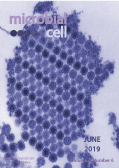Table of contents
Volume 6, Issue 6, pp. 267 - 298, June 2019
Cover: This digitally colorized transmission electron microscopic (TEM) image depicts numerous Chikungunya virus particles, which are composed of a central dense core that is surrounded by a viral envelope. Each virion is approximately 50nm in diameter (image by Cynthia Goldsmith, Centers for Disease Control and Prevention, USA; Public Health Image Library, image ID #17550); image modified by MIC. The cover is published under the Creative Commons Attribution (CC BY) license.
Enlarge issue cover
Yeast AP-1 like transcription factors (Yap) and stress response: a current overview
Claudina Rodrigues-Pousada, Frédéric Devaux, Soraia M. Caetano, Catarina Pimentel, Sofia da Silva, Ana Carolina Cordeiro and Catarina Amaral
Reviews |
page 267-285 | 10.15698/mic2019.06.679 | Full text | PDF |
Abstract
Yeast adaptation to stress has been extensively studied. It involves large reprogramming of genome expression operated by many, more or less specific, transcription factors. Here, we review our current knowledge on the function of the eight Yap transcription factors (Yap1 to Yap8) in Saccharomyces cerevisiae, which were shown to be involved in various stress responses. More precisely, Yap1 is activated under oxidative stress, Yap2/Cad1 under cadmium, Yap4/Cin5 and Yap6 under osmotic shock, Yap5 under iron overload and Yap8/Arr1 by arsenic compounds. Yap3 and Yap7 seem to be involved in hydroquinone and nitrosative stresses, respectively. The data presented in this article illustrate how much knowledge on the function of these Yap transcription factors is advanced. The evolution of the Yap family and its roles in various pathogenic and non-pathogenic fungal species is discussed in the last section.
Functional link between mitochondria and Rnr3, the minor catalytic subunit of yeast ribonucleotide reductase
Isaac Corcoles-Saez, Jean-Luc Ferat, Michael Costanzo, Charles M. Boone and Rita S. Cha
Research Articles |
page 286-294 | 10.15698/mic2019.06.680 | Full text | PDF |
Abstract
Ribonucleotide reductase (RNR) is an essential holoenzyme required for de novo synthesis of dNTPs. The Saccharomyces cerevisiae genome encodes for two catalytic subunits, Rnr1 and Rnr3. While Rnr1 is required for DNA replication and DNA damage repair, the function(s) of Rnr3 is unknown. Here, we show that carbon source, an essential nutrient, impacts Rnr1 and Rnr3 abundance: Non-fermentable carbon sources or limiting concentrations of glucose down regulate Rnr1 and induce Rnr3 expression. Oppositely, abundant glucose induces Rnr1 expression and down regulates Rnr3. The carbon source dependent regulation of Rnr3 is mediated by Mec1, the budding yeast ATM/ATR checkpoint response kinase. Unexpectedly, this regulation is independent of all currently known components of the Mec1 DNA damage response network, including Rad53, Dun1, and Tel1, implicating a novel Mec1 signalling axis. rnr3D leads to growth defects under respiratory conditions and rescues temperature sensitivity conferred by the absence of Tom6, a component of the mitochondrial TOM (translocase of outer membrane) complex responsible for mitochondrial protein import. Together, these results unveil involvement of Rnr3 in mitochondrial functions and Mec1 in mediating the carbon source dependent regulation of Rnr3.
Septin clearance from the division site triggers cytokinesis in budding yeast
Davide Tamborrini and Simonetta Piatti
Microreviews |
page 295-298 | 10.15698/mic2019.06.681 | Full text | PDF |
Abstract
In many eukaryotic cells cytokinesis involves a contractile actomyosin ring (CAR) that drives cleavage furrow ingression. What triggers CAR constriction at a precise time of the cell cycle and how constriction is coupled to chromosome segregation are fundamental questions. In the budding yeast Saccharomyces cerevisiae, CAR assembly strictly requires a rigid septin collar that forms at the bud neck early during the cell cycle. At the time of cytokinesis, a sudden remodelling of the septin collar occurs, leading to its splitting into two separate rings that sandwich the CAR. We have shown that septin displacement during splitting is an essential prerequisite for CAR constriction [Tamborrini et al., Nat Commun. 9(1):4308]. Thus, cytokinesis in budding yeast is a two-step mechanism: during the first step, the septin collar organizes the assembly of the cytokinetic machinery at the right place while restraining CAR-driven membrane ingression; during the second step, a confined eviction of septins from the division site during septin ring splitting triggers CAR constriction. Our data further indicate that septin ring splitting is prompted by the Mitotic Exit Network (MEN), and in particular by its downstream phosphatase Cdc14, independently of its mitotic exit function. Surprisingly, MEN signalling at spindle pole bodies (SPBs) is critical for septin ring splitting and cytokinesis. Ubiquitination of the MEN anchor at SPBs by the Dma1/2 ubiquitin ligase attenuates MEN signalling and could have a decisive role in coupling cytokinesis to chromosome and organelle segregation. Altogether, our data emphasize the importance of septin ring splitting, which has been mysterious so far, and highlight a novel mechanism to prevent CAR constriction and cytokinesis in unpropitious conditions.










